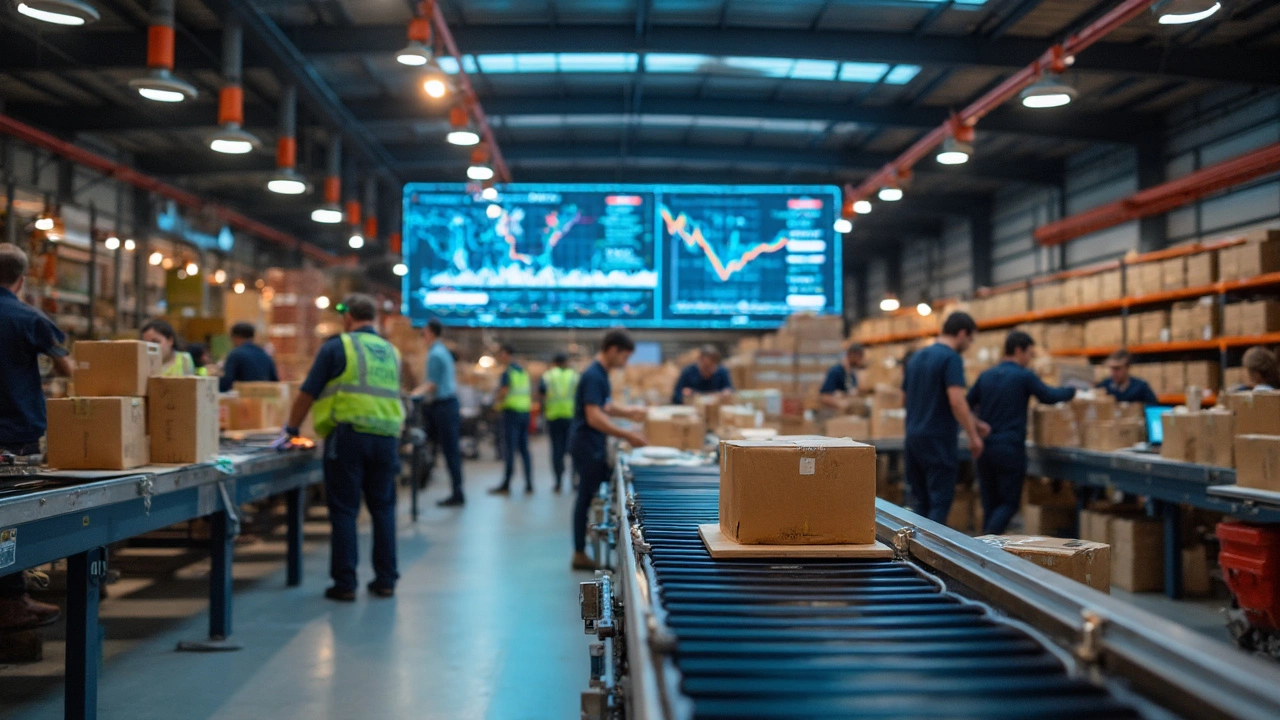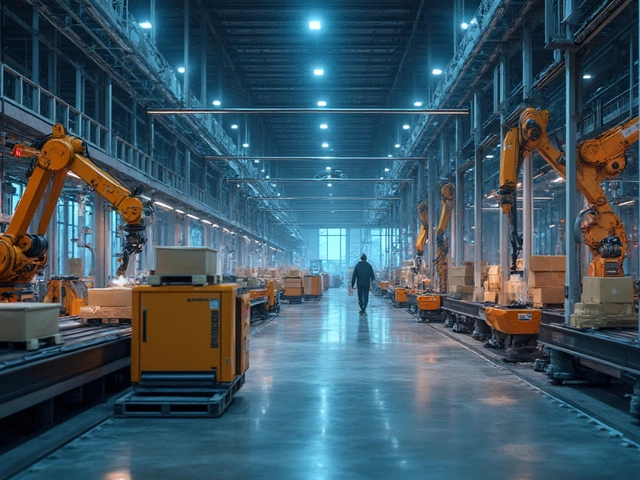Ever wondered why some online stores never run out of your favorite products, while others always seem to mess up your orders or take forever to deliver? Usually, the answer comes down to the difference between eCommerce and e logistics. People throw these words around like they mean the same thing, but trust me, they definitely don't.
eCommerce is about digital storefronts—think websites, shopping apps, or even marketplaces you browse on your phone. It's where sellers show off their products, take payments, and make it super easy for shoppers to fill their carts from the couch. But that's just half the story.
Once you hit “buy,” a whole new world kicks in: e logistics. This is where things really get interesting. e Logistics is the engine room behind your favorite shops. It covers everything from warehouses that stash your goodies to the routes delivery drivers take, and even how returns get handled. It's the part you almost never see, but you definitely notice when it goes wrong—like when a package goes missing or arrives looking like it fell off a truck.
- eCommerce: What It Really Means
- e Logistics Unpacked
- Key Differences At a Glance
- Why You Need Both for Success
- Common Misconceptions
- Tips for a Smooth Operation
eCommerce: What It Really Means
eCommerce isn’t just about buying stuff online. It’s the whole process of businesses selling products or services over the internet. If you’ve ever ordered takeout on your phone or grabbed a last-minute gift through an online shop, you’ve been part of eCommerce.
Here’s the thing—eCommerce covers way more than just setting up a website with a shopping cart. It brings together everything from digital storefronts, online payment processing, and virtual shopping assistants to customer service chatbots. Amazon, eBay, and small Shopify stores—they’re all playing the eCommerce game, just at different scales.
There are a bunch of different models too, depending on who’s selling and who’s buying:
- B2C (Business to Consumer): The classics—shops selling directly to folks like us. Think Nike.com.
- B2B (Business to Business): Companies selling to other companies, like a wholesaler supplying a retailer.
- C2C (Consumer to Consumer): People selling to other people—imagine you listing your old iPhone on eBay.
- C2B (Consumer to Business): Not as common, but it happens. For example, influencers selling their photos to brands.
People love eCommerce for simple reasons—no long lines, stores that never close, and access to way more products than any mall could hold. And honestly, it’s huge. Here’s what the numbers looked like recently:
| Year | Global eCommerce Sales (USD) |
|---|---|
| 2022 | $5.7 trillion |
| 2023 | $6.3 trillion |
With numbers like that, it’s no wonder everyone from local boutiques to giant retailers wants a piece of the online action.
The basic flow goes like this: a customer finds an item, checks out with a card or PayPal, and gets updates through email or SMS. But behind the scenes, the website software manages inventory, tracks customer data, and helps with marketing—all to make sure shoppers keep coming back.
e Logistics Unpacked
If you’ve ever tracked your package online and saw every stop it made, you were watching e logistics in action. Unlike the flashy shopping part of eCommerce, e logistics is all about the behind-the-scenes hustle—getting stuff from point A to B, accurately and on time.
e Logistics covers a bunch of moving parts. Let’s break down the main jobs:
- Warehousing: Where brands store their products. Big players like Amazon and Shein run massive fulfillment centers packed with shelves, robots, and staff making sure every item is in the right place.
- Inventory Management: Keeping tabs on what’s in stock and what’s running low. This helps stores avoid the whole “sold out” moment after you’ve already paid.
- Order Picking & Packing: When you order something, workers or robots pick out exactly what you bought, pack it safely, and prep it for shipping.
- Shipping & Delivery: Getting orders from warehouses to your front door. This is where big partnerships come in—think UPS, FedEx, DHL, or even tiny last-mile courier services.
- Returns Handling: Processing stuff you send back, which can get wild during refund season or after events like Black Friday.
Here’s a quick look at what happens after you check out on an online store:
- Your order pops up in their system.
- Inventory is checked to make sure your item is in stock.
- The item gets picked, packed up, and a shipping label is slapped on.
- A logistics partner picks it up for delivery.
- Tracking info is sent to your email or phone.
- If you change your mind, there’s a process for sending it back without a headache.
Even small mistakes in this process can mean late deliveries, lost packages, or annoyed customers. According to a 2024 report from Statista, 69% of online buyers say they won’t shop again with a retailer after a bad delivery experience. That’s a huge deal!
| e Logistics Task | Key Benefit | Big Player Example |
|---|---|---|
| Warehousing | Fast order fulfillment | Amazon Fulfillment Centers |
| Inventory Management | Less risk of stockouts | Shopify Inventory Tracking |
| Shipping & Delivery | Reliable arrivals | FedEx, UPS, DHL |
| Returns Handling | Happy, loyal customers | Zappos, Shein |
The secret sauce to great e logistics? Automation and data. Smart stores use real-time tracking, barcode scanners, and software that predicts what’ll be popular next week. It’s the not-so-glamorous, but totally essential backbone of the whole eCommerce world.
Key Differences At a Glance
It's super easy to mix up e logistics and eCommerce. They go hand-in-hand, but each has its own job. Here's what really separates them:
- Role in a business: eCommerce is the online shop everyone sees; e logistics is the behind-the-scenes action that gets your order to your door.
- Main tasks: eCommerce handles product listings, online payments, and customer service. e Logistics covers storing, packing, shipping, delivery, and returns.
- Customer interaction: eCommerce is all about what the shopper experiences online. e Logistics only becomes noticeable if something goes wrong—or when your order arrives fast and safe.
- Tech focus: eCommerce leans on web design, payment platforms, and marketing tools. e Logistics relies on warehouse management systems, inventory tracking, and delivery tracking apps.
- Revenue impact: Great eCommerce draws in buyers. Great e logistics keeps them coming back because the whole process just works hassle-free.
For a side-by-side peek, check out the table below—it spells out the main differences.
| Feature | eCommerce | e Logistics |
|---|---|---|
| Core Function | Online selling, payment processing | Order fulfillment, shipping, returns |
| Key Tools | Website builders, shopping carts, marketing platforms | Warehouse systems, inventory software, delivery networks |
| Direct Touchpoint | Customer-facing website | Physical product movement |
| Primary Goal | Drive sales online | Get products to customers efficiently |
| When Issues Show Up | Payment errors, website crashes | Late/missing packages, broken items |
Here's a cool stat: In 2024, over 70% of cart abandonments happen because of shipping or delivery concerns, not website glitches. That’s just one reason businesses can’t afford to ignore the logistics side if they want to keep buyers happy. When you set up your store, pay attention to both sides. It will save you a lot of headaches and keep customers coming back.

Why You Need Both for Success
Picture this: your online store has a beautiful website, awesome products, and a smooth checkout. But if your shipping is slow or orders get mixed up, shoppers will bail—and they probably won't come back. That's why eCommerce and e logistics have to work hand in hand if you want your business to actually grow.
Think about it: over 70% of customers in a 2024 Shopify survey said they stopped shopping at a store after a single bad delivery experience. It takes just one mess-up to lose them for good. That's huge. So it's not just about having cool stuff to sell online; you need a trusted system for getting products from A to B fast and without drama.
"People don’t come back for a fancy website—they come back for fast delivery and orders done right the first time." — Laura Beattie, Logistics Consultant at Supply Chain Simplified
Here's how these two worlds support each other:
- eCommerce brings the customers, manages payments, and collects order details.
- e Logistics handles the storage, picking, packing, shipping, and handling returns.
If one side drops the ball, the whole process falls apart. And if you’re aiming for higher margins, smart logistics can actually save you money, too. Check out some real numbers:
| Issue | Impact on Online Stores |
|---|---|
| Late Deliveries | 45% fewer repeat customers (BigCommerce, 2024) |
| Out-of-Stock Items | 8% lost sales on average (Adobe Analytics, 2024) |
| Efficient e Logistics | Up to 20% cost savings per order (McKinsey, 2023) |
So, if you ignore either side, you’re basically leaving money—and loyal customers—on the table. Make both work together, and you’ve set yourself up for happier shoppers and more profit.
Common Misconceptions
You’d be surprised how often people mix up e logistics and eCommerce. It’s almost like thinking the chef and the waiter in a restaurant do the same thing. They work together, but their jobs are very different.
Here are some of the biggest myths out there:
- Myth 1: eCommerce handles everything after you hit buy. Lots of folks think that when you order something online, the job is done for the store. Actually, the real work is just starting—e logistics kicks in to pick, pack, ship, and (if needed) handle returns.
- Myth 2: e logistics is only about delivery vans. It’s way more than that. It covers storage, inventory management, tracking, sorting, and even customer notifications about delivery status.
- Myth 3: Faster shipping means better eCommerce. Speedy delivery is cool, but it’s a logistics win, not a sign that the eCommerce side is doing something magical. Without organized logistics behind the scenes, even the prettiest online shop can leave customers waiting too long.
Let’s put some real numbers behind why this confusion matters. According to the 2024 Omnitrack Retail Report, 72% of customers said late or missing deliveries made them think twice about shopping with the same store. And out of those complaints, more than 60% were problems with logistics, not with the eCommerce site experience.
| Issue | % of Customer Complaints | Main Cause |
|---|---|---|
| Late Delivery | 52% | e Logistics glitch |
| Item Out of Stock | 21% | Inventory mismanagement (logistics) |
| Website Payment Error | 6% | eCommerce platform |
| Poor Tracking Updates | 13% | e Logistics communication |
| Other | 8% | Mixed/Unknown |
The takeaway: if a store has smooth logistics, returns are easy and deliveries arrive on time. But don’t expect the eCommerce website alone to magically solve those headaches. Next time you place an order, remember both sides need to work—otherwise, everyone ends up frustrated.
Tips for a Smooth Operation
The smoother your eCommerce and logistics work together, the happier your customers will be. It's not rocket science, but you'll want to keep a few things tight to avoid headaches and refunds.
- e logistics needs real-time updates. Customers want to know exactly where their package is. Invest in software that gives tracking updates—not just for customers but for you, too.
- Keep your warehouse organized. Messy storage leads to lost items, slower packing, and shipping delays. Even huge brands like Amazon rely on barcode systems and strict order-picking zones to keep things zipping along.
- Don’t skip inventory checks. Businesses that do weekly or even daily inventory counts see way fewer out-of-stock problems, so set a schedule that fits your sales volume.
- Choose delivery partners wisely. Cheap can cost you more in angry reviews if your shipping company is unreliable. Research their delivery success rates before signing anything.
- Use automation for repeatable tasks. Things like sending order confirmations, updating inventory, and scheduling pickups can all run on autopilot. This cuts down on mistakes and saves serious time.
Here’s how much of a difference good logistics can make. According to Statista, 62% of shoppers say quick and accurate delivery is what keeps them coming back. Mess that up, and nearly half will bounce to a competitor after a single bad experience.
| Key Area | Best Practice |
|---|---|
| Inventory Management | Daily digital tracking |
| Order Fulfillment | Barcode scanning and auto-verification |
| Shipping Updates | Automated SMS/email alerts |
| Returns Handling | Clear, simple online process |
Small tweaks can seriously up your game. If you’re just starting, start simple—maybe a Shopify plugin for inventory or a courier with solid tracking. As you grow, look into a warehouse management system or partner with a logistics provider that knows eCommerce inside and out.





